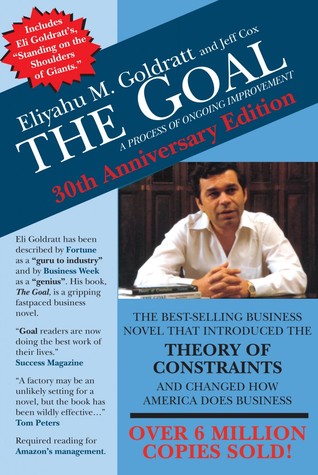More on this book
Community
Kindle Notes & Highlights
Read between
December 15 - December 31, 2018
“They’re measurements which express the goal of making money perfectly well, but which also permit you to develop operational rules for running your plant,” he says. “There are three of them. Their names are throughput, inventory and operational expense.”
“Throughput,” he says, “is the rate at which the system generates money through sales.”
a measurement not clearly defined is worse than useless.
Increase throughput while simultaneously reducing both inventory and operating expense.
dependent events are in combination with another phenomenon called ‘statistical fluctuations,’
covariance,
A mathematical principle says that in a linear dependency of two or more variables, the fluctuations of the variables down the line will fluctuate around the maximum deviation established by any preceding variables. That explains what happened in the balanced model.
“Right from the start, in the days of ancient Greece, people postulated that underlying the phenomenal variety of materials there must be a simple set of elements from which all other substances are composed.”
‘what to change?’, ‘what to change to?’, and ‘how to cause the change?’
All we are doing is looking at the time line from the moment the customer gives us an order to the point when we collect the cash. And we are reducing that time line…
In summary, both Ford and Ohno followed four concepts (from now on we’ll refer to them as the concepts of flow):
1. Improving flow (or equivalently lead time) is a primary objective of operations. 2. This primary objective should be translated into a practical mechanism that guides the operation when not to produce (prevents over production). Ford used space; Ohno used inventory. 3. Local efficiencies must be abolished. 4. A focusing process to balance flow must be in place. Ford used direct observation. Ohno used the gradual reduction of the number of containers and then gradual reduction of parts per container.
U-cells
Five Focusing Steps 1. IDENTIFY the system’s constraint. 2. Decide how to EXPLOIT the system’s constraint. 3. SUBORDINATE everything else to the above decisions. 4. ELEVATE the system’s constraint. 5. If in the previous steps a constraint has been broken Go back to step 1, but do not allow inertia to cause a system constraint.
1. IDENTIFY the system’s constraint. 2. Decide how to EXPLOIT the system’s constraint. 3. SUBORDINATE everything else to the above decisions. 4. ELEVATE the system’s constraint. 5. If in the previous steps a constraint has been broken Go back to step 1, but do not allow inertia to cause a system constraint.
“I smile and start to count on my fingers: One, people are good. Two, every conflict can be removed. Three, every situation, no matter how complex it initially looks, is exceedingly simple. Four, every situation can be substantially improved; even the sky is not the limit. Five, every person can reach a full life. Six, there is always a win-win solution. Shall I continue to count?”


